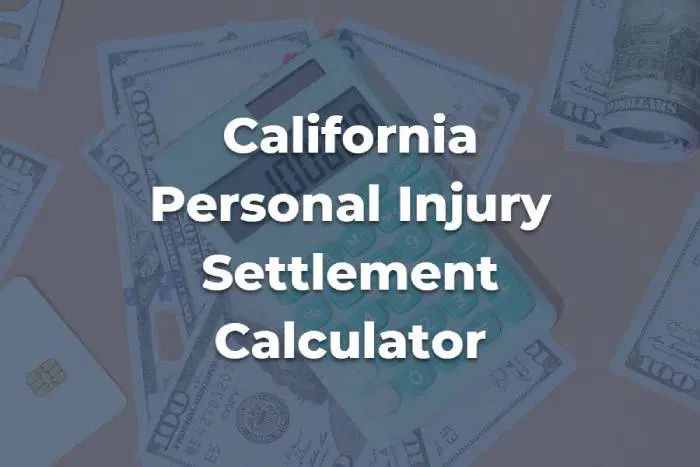
Best Personal Injury Settlement Calculator for Californians
Legally reviewed by: Jessica Anvar Stotz, JD, MBA
As a State Bar Certified California attorney referral service we have people call every week asking how much their personal injury case could be worth. To help them and you answer that question, we designed the California personal injury calculator below to help approximate your settlement. Input your case details below and receive a settlement estimate in 90 seconds or less.
*This personal injury settlement calculator is provided for informational purposes only and is not a substitute for professional legal advice. The calculations generated by this tool are based on general factors and formulas commonly used in personal injury settlements.
Personal Injury Damages You Could Receive
In California, personal injury claims may involve various types of damages that an injured party can seek. Here are the main categories of damages available in personal injury claims in California:
Economic Damages
Medical Expenses:
- Compensation for current and future medical costs.
- Includes hospital stays, surgeries, rehabilitation, medication, and ongoing medical care.
Lost Wages
- Reimbursement for income lost due to the injury.
- Covers the period when the injured person is unable to work or is on reduced working hours.
Property Damage
Compensation for damage to the plaintiff’s property (e.g., vehicle damage in a car accident).
Future Damages
- Anticipated expenses or losses that will occur in the future due to the injury.
- Includes ongoing medical treatment, future lost wages, and long-term care costs.
Non-Economic Damages
General Damages:
- Compensation for non-economic losses such as pain and suffering and loss of enjoyment of life.
Emotional Distress
- Compensation for psychological and emotional trauma resulting from the accident.
- May include anxiety, depression, and post-traumatic stress disorder (PTSD).
Loss of Consortium
- Damages awarded to a spouse or family member for the loss of companionship, support, and intimacy due to the injury.
Pain and Suffering
- Non-economic damages for physical and emotional pain caused by the injury.
- Difficult to quantify but aims to compensate for the impact on the individual’s quality of life.
Wrongful Death Damages
- Available in cases where the injury leads to death.
- Includes compensation for funeral expenses, loss of financial support, and emotional suffering of surviving family members.
Loss of Enjoyment of Life
- Addresses the impact of the injury on the individual’s ability to enjoy hobbies, activities, and overall quality of life.
Punitive Damages
- Awarded in cases of extreme negligence or intentional misconduct.
- Aimed at punishing the at-fault party and deterring similar behavior in the future.
How Negligence Comes Into Play
Negligence is a key concept in personal injury cases in California. To establish a successful personal injury claim, the plaintiff (injured party) typically needs to demonstrate that the defendant (at-fault party) was negligent. Here’s how negligence comes into play in California personal injury cases.
Elements of Negligence
- Duty of Care:
- The plaintiff must show that the defendant owed them a duty of care. This duty varies depending on the circumstances but generally involves acting reasonably to prevent harm.
- Breach of Duty:
- The plaintiff must demonstrate that the defendant breached the duty of care. This means the defendant failed to act as a reasonably prudent person would have in similar circumstances.
- Causation:
- There must be a direct link between the defendant’s breach of duty and the plaintiff’s injuries. The plaintiff must show that the defendant’s actions or negligence directly caused harm.
- Damages:
- The plaintiff needs to prove actual damages, such as medical expenses, lost wages, pain and suffering, or other losses resulting from the injury.
Comparative Negligence
California follows a comparative negligence system. This means that even if the plaintiff is partially responsible for the accident, they can still recover damages, but the amount may be reduced in proportion to their degree of fault. However, if the plaintiff is found to be more than 50% at fault, they may be barred from recovering any damages.
Negligence Per Se
In some cases, a plaintiff can establish negligence per se. This occurs when the defendant violates a law or regulation designed to protect a specific group of people, and the plaintiff is a member of that group. If the plaintiff can prove negligence per se, it can simplify the process of establishing the defendant’s breach of duty.
Defenses to Negligence
Defendants in personal injury cases may raise various defenses, including:
- Assumption of Risk: The plaintiff knowingly accepted the risks associated with a particular activity.
- Contributory Negligence: The plaintiff’s own negligence contributed to the injury.
- Statute of Limitations: The lawsuit was not filed within the specified timeframe.
Role of Evidence and Legal Representation
Collecting evidence, such as witness statements, photographs, and expert testimony, is crucial to proving negligence. It’s advisable for individuals pursuing a personal injury claim to seek legal representation to navigate the complexities of negligence law and build a strong case.
Understanding negligence and its elements is fundamental to pursuing a successful personal injury claim in California. Consulting with a personal injury attorney can provide tailored guidance based on the specific circumstances of the case.
What Factors Generally Make a “Strong” Personal Injury Case
Several factors can contribute to a personal injury case being considered strong for the injured victim. Keep in mind that each case is unique, and the strength of a case depends on specific circumstances. Here are key factors that often indicate a strong personal injury case:
1. Clear Liability
- If there is clear evidence demonstrating the other party’s fault or negligence, it strengthens the case. This evidence may include eyewitness accounts, photographs, videos, or police reports.
2. Documented Injuries
- Thorough documentation of injuries, including medical records, photographs, and expert medical opinions, can bolster the case. The severity and extent of injuries often play a significant role in determining damages.
3. Prompt Medical Attention
- Seeking prompt medical attention after the incident reinforces the legitimacy of injuries. Delayed medical treatment may be used by the defense to question the connection between the accident and the injuries.
4. Consistent Statements
- Consistency in the victim’s statements and accounts of the incident strengthens credibility. Any discrepancies or contradictions can be exploited by the opposing party.
5. Witness Testimonies:
- Eyewitnesses who can corroborate the victim’s version of events can add significant strength to the case. Independent witnesses can provide unbiased accounts of what transpired.
6. Adherence to Treatment Plans
- Following prescribed medical treatment plans and attending all necessary appointments demonstrates a commitment to recovery. It also reinforces the link between the accident and the resulting injuries.
7. Lost Income and Financial Impact
- If the victim has suffered a significant financial impact due to the injury, such as lost wages or earning capacity, it adds weight to the damages claimed.
8. Evidence Preservation
- Timely preservation of evidence, such as preserving accident scenes, vehicle damage, or other relevant physical evidence, can be crucial. This prevents the loss or deterioration of evidence over time.
9. Defendant’s Resources
- If the at-fault party or their insurance has sufficient resources, it may increase the likelihood of a successful settlement or judgment. Adequate resources enhance the ability to recover damages.
10. Admission of Fault
- If the at-fault party has admitted fault or liability, either verbally or in writing, it can significantly strengthen the victim’s case.
11. Legal Representation
- Having an experienced personal injury attorney can greatly enhance the strength of a case. An attorney can navigate legal complexities, negotiate effectively, and advocate for the victim’s rights.
It’s important to consult with a personal injury attorney to assess the specific circumstances of a case. An attorney can provide tailored advice and guide the injured victim through the legal process, maximizing the chances of a favorable outcome.
Get Connected With an Attorney
Looking to get a settlement estimate for your potential personal injury case? Contact LawLinq today to speak with some of the best personal injury attorneys in the state. All initial consultations are free.


